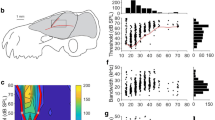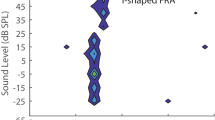Summary
-
1.
Electrophysiological properties of 279 single units in the superior colliculus (SC) of the big brown bat,Eptesicus fuscus, were studied by recording their responses to pure tone pulses and frequency-modulated stimuli.
-
2.
The SC units generally fired only a few impulses to acoustic stimulus. They are not tonotopically organized along the dorsoventral axis of the SC (Fig. 1).
-
3.
The response latency of 276 units was between 3.6 and 20 ms, but most (253 units) were below 12.5 ms (Fig. 2).
-
4.
Tuning curves of 164 units are either narrow, intermediate, or broad, according to the bandwidth of the tuning curves (Fig. 3). Q10 dB values range between 1.21 (best frequency (BF) =33.52 kHz) and 68.9 (BF=69.94 kHz), but the majority are below 20. The minimum thresholds (MTs) of these units were between 15 and 104 dB SPL, but most were above 40 dB SPL.
-
5.
MTs to pure tone pulses and one octave upward and downward sweeping FM stimuli were compared (Fig. 4). SC units generally had their lowest MTs to downward sweeping FM stimuli and their highest MTs to pure tone pulses (Table 1).
-
6.
Intensity-rate functions of 16 SC units were measured with both pure tone pulses and upward and downward sweeping FM stimuli. There was no correlation between the type of intensity-rate function obtained and the type of acoustic stimulus used (Fig. 5).
-
7.
Auditory spatial response areas were measured for 47 units. The size of the spatial response area increases with stimulus intensity (Fig. 6). The auditory space is not orderly represented in the SC of a bat (Fig. 7).
Similar content being viewed by others
Abbreviations
- BF :
-
best frequency
- FM :
-
frequency modulated
- IC :
-
inferior colliculus
- MT :
-
minimum threshold
- SC :
-
superior colliculus
References
Baron G (1977) Signification éco-éthologique du développement allométrique des deux systemes visuels chez les chirop tères. Rev Can Biol 36:1–16
Friend JH, Suga N, Suthers RA (1966) Neural responses in the inferior colliculus of echolocating bats to artificial orientation sounds and echoes. J Cell Comp Physiol 67:319–332
Griffin DA (1944) Echolocation by blind men, bats and radar. Science 100:5 89–590
Griffin DR (1958) Listening in the dark. Yale University Press, New Haven, Connecticut (Reprinted by Dover Publications, New York, 1974)
Grinnell AD (1963) The neurophysiology of audition in bats: Intensity and frequency parameters. J Physiol (London) 167:38–66
Grinnell AD, Schnitzler H-U (1977) Directional sensitivity of echolocation in the horseshoe batRhinolophus ferrumequinum. II. Behavioral directionality of hearing. J Comp Physiol 116:63–76
Henkel CK, Edwards StB (1978) The superior colliculus control of pinna movements in the cat: possible anatomical connections. J Comp Neurol 182:763–776
Jastreboff PJ, Tarnecki R (1975) Response of cat cerebellar vermis induced by sound. I. Influence of drugs on responses of single units. Acta Neurobiol Exp 35:209–216
Jen PH-S (1982) Echolocation in the bat: obstacle avoidance by the bat and signal coding in the bat's cerebellum. Proc Natl Sci Council (ROC) 6:71–80
Jen PH-S, Schlegel PA (1980) Neurons in the cerebellum of echolocating bats respond to acoustic signals. Brain Res 196:502–507
Jen PH-S, Schlegel PA (1982) Auditory physiological properties of the neurons in the inferior colliculus of the big brown bat,Eptesicus fuscus. J Comp Physiol 147:351–363
Jen PH-S, Vater M, Harnischfeger G, Rübsamen R (1981) Mapping of the auditory area in the cerebellar vermis and hemispheres of the little brown bat,Myotis lucifugus. Brain Res 219:156–161
Jen PH-S, Sun X, Kamada T (1982) Responses of cerebellar neurons of the CF-FM bat,Pteronotus parnellii to acoustic stimuli. Brain Res 252:167–171
Kiang NY-S (1965) Discharge patterns of single nerve fibers in the cat's auditory nerve. Res Monogr 35, MIT Press, Cambridge, Massachusetts
Knudsen EI (1982) Auditory and visual maps of space in the optic tectum of the owl. J Neurosci 9:1177–1194
Neuweiler G (1980) Auditory processing of echoes: peripheral processing. In: Busnel RG, Fish JF (eds) Animal sonar systems. Plenum Press, New York, pp 519–548
Peterson PG, Gross EE (1972) Handbook of noise measurement, General Radio Company, pp 188–191
Pollak GD (1980) Organizational and encoding features of single neurons in the inferior colliculus of bats. Busnel RG, Fish JF (eds) Animal sonar systems. Plenum Press, New York, pp 549–588
Pollak GD, Marsh D, Bodenhamer R, Souther A (1978) A single unit analysis of the inferior colliculus in unanesthetized bats: Response patterns and spike count functions generated by constant frequency and frequency-modulated sounds. J Neurophysiol 41:677–691
Shimozawa T, Suga N, Hendler P, Schuetze S (1974) Directional sensitivity of echolocating system in bats producing frequency-modulated signals. J Exp Biol 60:53–59
Sprague JM, Meikle TH Jr (1965) The role of the superior colliculus in visually guided behaviour. Exp Neurol 11:115–146
Suga N (1973) Feature extraction in the auditory system of bats. In: Møller AR (ed) Basic mechanisms in hearing. Academic Press, New York, pp 675–744
Suga N (1982) Functional organization of the auditory cortex: representation beyond tonotopy in the bat. Woolsey CN (ed) Cortical sensory organization, vol 3. Humana Press, New Jersey, pp 157–218
Suga N, Schlegel P (1973) Coding and processing in the auditory systems of FM-signal-producing bats. J Acoust Soc Am 54:174–190
Suga N, Simmons JA, Jen PH-S (1975) Peripheral specialization for fine analysis of Doppler-shifted echoes in ‘CF-FM’ batPteronotus parnellii. J Exp Biol 63:161–192
Sun X, Jen PH-S, Kamada T (1983) Mapping of the auditory area in the cerebellar vermis and hemispheres of the mustache bat,Pteronotus parnellii parnellii. Brain Res 271:162–165
Sun X, Jen PH-S, Kamada T (1983b) Neurons in the superior colliculus of echolocating bats respond to ultrasonic signals. Brain Res 275:148–152
Vater M, Schlegel PA, Zöller H (1979) Comparative auditory neurophysiology of the inferior colliculus of two molossid bats,Molossus ater andMolossus molossus. I. Gross evoked potentials and single unit responses to pure tones. J Comp Physiol 131:137–145
Zvorykin FP (1959) Morphological basis of locative and supersonic abilities in the bat (in Russian). Arkh Anat Gistol Embriol 36:19–31
Author information
Authors and Affiliations
Rights and permissions
About this article
Cite this article
Jen, P.H., Sun, X., Kamada, T. et al. Auditory response properties and spatial response areas of superior collicular neurons of the FM bat,Eptesicus fuscus . J. Comp. Physiol. 154, 407–413 (1984). https://doi.org/10.1007/BF00605239
Accepted:
Issue Date:
DOI: https://doi.org/10.1007/BF00605239




